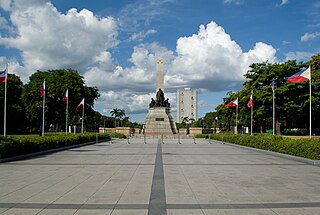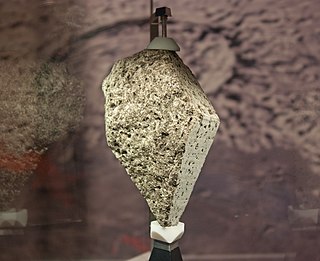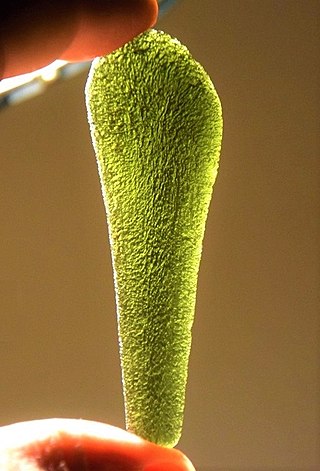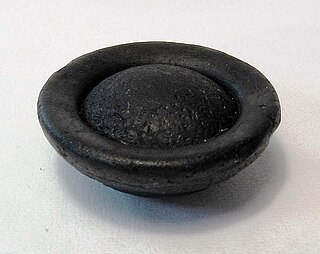
Tektites are gravel-sized bodies composed of black, green, brown or grey natural glass formed from terrestrial debris ejected during meteorite impacts. The term was coined by Austrian geologist Franz Eduard Suess (1867–1941), son of Eduard Suess. They generally range in size from millimetres to centimetres. Millimetre-scale tektites are known as microtektites.

Rodriguez, officially the Municipality of Rodriguez and commonly known by its former name Montalban, is a 1st class urban municipality in the province of Rizal, Philippines. According to the 2020 census, it has a population of 443,954 people making it the most populous municipality in the country. Pending an affirmation through plebiscite, Republic Act No. 11812 repealed Batas Pambansa Blg. 275 and intend to formally revert to its original municipal name Montalban.

Campo del Cielo refers to a group of iron meteorites and the area in Argentina where they were found. The site straddles the provinces of Chaco and Santiago del Estero, located 1,000 kilometers (620 mi) north-northwest of Buenos Aires, Argentina and approximately 500 kilometres (310 mi) southwest of Asunción, Paraguay. The crater field covers 18.5 by 3 kilometres and contains at least 26 craters, the largest being 115 by 91 metres.

Miguel Malvar y Carpio was a Filipino general who served during the Philippine Revolution and, subsequently, during the Philippine–American War. He assumed command of the Philippine revolutionary forces during the latter, following the capture of resistance leader Emilio Aguinaldo by the Americans in 1901. According to some, he could have been listed as one of the presidents of the Philippines. However, is not recognized as such by the Philippine government.

Rizal Park, also known as Luneta Park or simply Luneta, is a historic urban park located in Ermita, Manila. It is considered one of the largest urban parks in the Philippines, covering an area of 58 hectares. The site on where the park is situated was originally known as Bagumbayan during the Spanish colonial period. It is adjacent to the historic Walled City of Intramuros.

Anda, officially the Municipality of Anda, is a 3rd class municipality in the province of Bohol, Philippines. According to the 2020 census, it has a population of 17,778 people.

Moon rock or lunar rock is rock originating from Earth's Moon. This includes lunar material collected during the course of human exploration of the Moon, and rock that has been ejected naturally from the Moon's surface and landed on Earth as meteorites.

Moldavite is a forest green, olive green or blue greenish vitreous silica projectile glass formed by a meteorite impact in southern Germany that occurred about 15 million years ago. It is a type of tektite and a gemstone. Material ejected from the impact crater includes moldavite, which was strewn across parts of Germany, the Czech Republic and Austria.

Iron meteorites, also called siderites or ferrous meteorites, are a type of meteorite that consist overwhelmingly of an iron–nickel alloy known as meteoric iron that usually consists of two mineral phases: kamacite and taenite. Most iron meteorites originate from cores of planetesimals, with the exception of the IIE iron meteorite group.

The Sambal people are a Filipino ethnolinguistic group living primarily in the province of Zambales and the Pangasinense municipalities of Bolinao, Anda, and Infanta. The term may also refer to the general inhabitants of Zambales. They were also referred to as the Zambales during the Spanish colonial era.

Georgiaite is a rare form of tektite found only in the state of Georgia in the southeastern United States. These tektites are found in part of the North American strewn field coming from what is believed to be the Chesapeake Bay impact crater in the late Eocene epoch over 35 million years ago. Two strewn fields and tektite groups are currently associated with this impact: the black bediasites in Texas and the green georgiaites in Georgia.

The Australasian strewnfield is the youngest and largest of the tektite strewnfields, with recent estimates suggesting it might cover 10%–30% of the Earth's surface. Research indicates that the impact forming the tektites occurred around 788,000 years ago, most likely in Southeast Asia. The probable location of the crater is unknown and has been the subject of multiple competing hypotheses.
The Sambalic languages are a part of the Central Luzon language family spoken by the Sambals, an ethnolinguistic group on the western coastal areas of Central Luzon and the Zambales mountain ranges.

The Peekskill meteorite is the object resulting from a well-documented meteorite event that occurred in October, 1992, in Peekskill, New York, United States. Sixteen separate video recordings document the meteorite burning through the Earth's atmosphere, whereupon it struck a parked car in Peekskill. The Peekskill meteorite is an H6 monomict breccia; its filigreed texture is the result of the shocking and heating following the impact of two asteroids in outer space. The meteorite is of the stony variety, and approximately 20% of its mass is tiny flakes of nickel-iron. When it struck Earth, the meteorite weighed 27.7 pounds (12.6 kg) and measured one foot in diameter. The Peekskill meteorite is estimated to be 4.4 billion years old.

"Piloncitos" is a collectors' term for the bead-like gold masa coins used during the aristocratic era of the Philippines and in the early years of Spanish foreign rule, called bulawan in many Philippine languages or salapi ("coin") or ginto in Tagalog. These are pieces that formed part of various degrees of Southeast Asian gold weight such as amás or táhil. Gold coinage was used along with silver coinage in maritime Southeast Asian currency.

There have been several names of the Philippines in different cultures and at different times, usually in reference to specific island groups within the current archipelago. Even the name Philippines itself was originally intended to apply only to Leyte, Samar, and nearby islands. It was bestowed by the Spanish explorer Ruy López de Villalobos or one of his captains Bernardo de la Torre in 1543 in honor of the crown prince Philip, later Philip II. Mindanao, which they reached first and assumed to be the greater land, they named after the reigning emperor Charles V, who was also Spain's king Carlos I. Over the course of Spanish colonization, the name was eventually extended to cover the entire chain. It has survived with minor changes. The Philippine Revolution called its state the Philippine Republic. The US military and civilian occupations called their territory the Philippine Islands. During the Third Philippine Republic, the state's official name was formally changed to the Philippines.

José Protasio Rizal Mercado y Alonso Realonda was a Filipino nationalist, writer and polymath active at the end of the Spanish colonial period of the Philippines. He is considered a national hero of the Philippines. An ophthalmologist by profession, Rizal became a writer and a key member of the Filipino Propaganda Movement, which advocated political reforms for the colony under Spain.

Australites are tektites found in Australia. They are mostly dark or black, and have shapes including discs and bowls that are not seen in other tektites. NASA used the shape of "flanged button" australites in designing re-entry modules for the Apollo program in the 1960s.

The archaeology of the Philippines is the study of past societies in the territory of the modern Republic of the Philippines, an island country in Southeast Asia, through material culture.

Tasmanite are tektites found in Tasmania, a regional form of australite, the most common type of tektite, glass of meteorite origin, traditionally named for its geographic location. Quite often, tasmanites are found in the literature under the name australites, together with which they are included in a very broad category of tektites, originating from the largest Australasian tektite strewnfield on earth. In the northern part of the scatter field, australites partially overlap and connect with part of the range of indochinites, and on the southern border they are present under the name tasmanites. In general, all of the listed regional tektites are included in the general class of indochinites-australites, sometimes referred to under the summary name Australasian tektites.






















